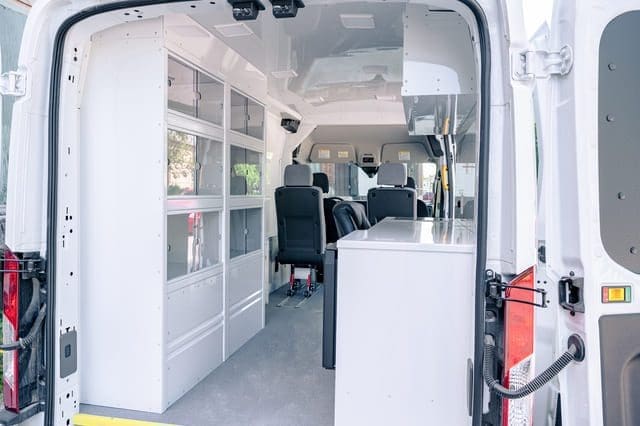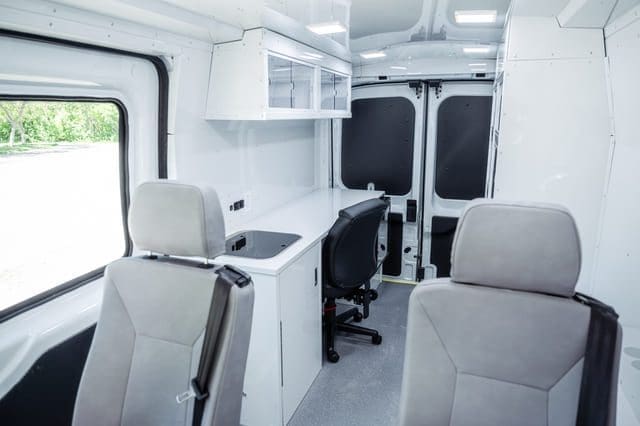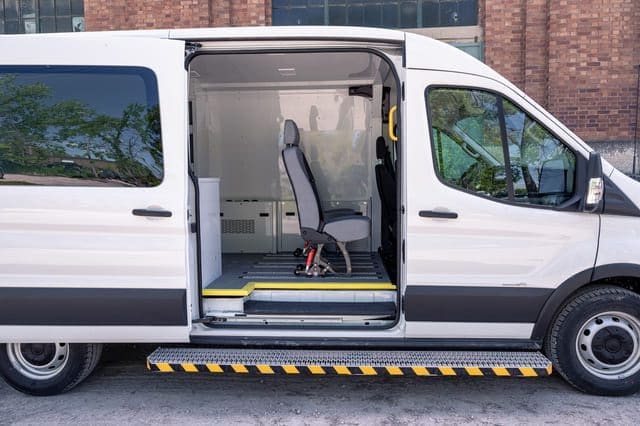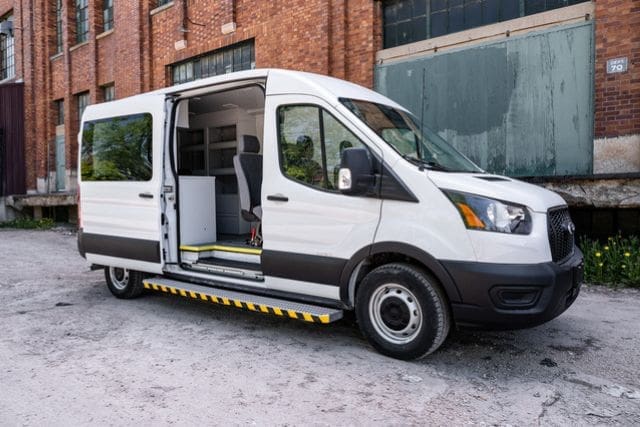Did you know that 90% of American adults think the country is dealing with a mental health crisis? Many individuals facing crises are homeless, broke, live in isolated areas, or don’t have transportation to get the help they need.
It’s frustrating and heartbreaking to know that many lack the resources or the right support system to get the help they need. Your organization wants to make a difference, but traditional healthcare and support systems seem inadequate. This is where a crisis stabilization unit can make a big impact.
At AVAN Mobility, we feel your frustration and share your commitment to helping those in need. For over ten years, we’ve been dedicated to creating vehicles that bridge the gap in healthcare access. We specialize in designing and building mobile medical units that reach people where they are, providing the critical care they need.
Our crisis stabilization units are crafted with the same care and expertise, aiming to offer immediate support during crises. We know there are other options out there, but we want to share our knowledge to help you find the best solution for your organization and the communities it will serve.
In this article, you’ll learn what a crisis stabilization unit is and how it can help your organization provide immediate, effective support during crises. We’ll discuss the features, benefits, and practical applications of these units.
What you need to know about crisis stabilization units
The affordability of healthcare, drug addiction, and mental health issues are some of the biggest crises in the country. These problems often connect and lead to even bigger crises. For example, someone struggling with mental health might not be able to afford treatment. This can lead to drug addiction as a way to cope, which then spirals into a bigger health crisis.

The solution: crisis stabilization units
A crisis stabilization unit is a special kind of vehicle designed to help people right where they are. It provides a safe, private, and confidential space where people can get help from professionals. Here’s how it can make a difference:
Immediate support: Crisis stabilization units offer immediate help for people in crisis. This means they don’t have to wait days or weeks to see a professional.
A support system: Inside a mobile crisis unit, individuals can talk to caring professionals who listen and understand. This support can make a huge difference for someone feeling alone.
Referrals for further help: The crisis stabilization unit can provide information on where to get more help, such as long-term counseling or further medical treatment.
Confidential space: People can talk about their problems without fear of being overheard. A mobile crisis unit ensures privacy, making it easier for individuals to open up and seek help.
Imagine a person struggling with depression and drug addiction. Without access to affordable healthcare, they might feel trapped. But maybe people who need help are googling “crisis stabilization unit near me.” With a crisis stabilization unit nearby, they can get immediate support, talk to someone who cares, and learn about where to get more help. This way, they don’t have to suffer in silence.
In the next section, you’ll learn about the Mobile Outreach Van and how your organization can use it as a crisis stabilization unit.
What Is a Mobile Outreach Van and How Can It Be Used as a Crisis Stabilization Unit?

The Mobile Outreach Van is a specially designed vehicle that can serve as a crisis stabilization unit. Here are some features of this van and how your organization can use them to help people going through tough times.
Clean, comfortable environment

The Mobile Outreach Van offers a clean and comfortable space. Imagine someone who has been living on the streets, feeling scared and alone. Stepping into a clean, welcoming van can make them feel safe and cared for.
Floor-to-ceiling, slide-to-open cabinets

- Storage for supplies: Your team can store blankets, first aid kits, hygiene products, and other supplies in these cabinets so that they’re always handy.
- Quick access: Slide-to-open cabinets enable your team to get what they need fast.
Power supply

- Reliable power: Outlets, 12V plugs, and USB ports are available.
- Use of devices: The power supply allows counselors to use laptops or connect with other support services.
- Charging stations: USB ports keep phones charged so people in the van can stay in touch.
Rear heat & air conditioning
- Comfortable temperature: Keeps the van warm in winter and cool in summer.
- Well-being: The climate-controlled environment helps people feel better physically and emotionally.
Removable passenger seats

- Flexibility: Seats can be taken out to make more space.
- Room for medical equipment: Additional space means more people can be in the van, or there will be more room to use medical equipment.
Mobile office desk space with secured rolling chair

- Workspace: The desk gives counselors a place to sit and fill out paperwork.
- Organized: An organized and professional setting helps increase the trust people have in your team.
Overhead storage with optional lockable upper cabinets
- Secure storage: Keeps important documents and medicines safe.
- Accessible: The upper cabinets are easy to reach and take things from.
Sink and fridge with under-sink water supply

- Hygiene: The sink allows for quick clean-ups and handwashing.
- Refreshments: The fridge can store water bottles and snacks for people in distress.
Bright LED interior lighting
- Well-lit space: A brightly-lit van makes it feel safe and comfortable, especially at night.
Additional options
- Cab divider: This feature makes counseling sessions feel more private, secure, and confidential.
- Winter tires: With winter tires, you’ll feel safer on winter roads when the snow can make driving difficult.
- Grab handles: People with mobility issues will have extra support with the grab handles.
The Mobile Outreach Van’s variety of features makes it a great option for crisis stabilization. This mobile unit can provide immediate support, comfort, and care to people in crisis, helping them through their hardest times.
Want to learn more about the crisis stabilization unit?

You came to this article looking for ways to help people through crises, especially those who lack access to transportation or financial resources, to seek help. We understand your challenges and your desire to make a difference.
After reading this article, you now know what a crisis stabilization unit is and how it works. You also learned about the features of a Mobile Outreach Van and how it can be used as a crisis stabilization unit to start helping people in need.
At AVAN Mobility, we don’t like seeing people facing barriers to healthcare or transportation. We believe everyone should have equal access, no matter where they’re located or what crisis they’re facing. If you’re ready to start helping people with a mobile crisis unit, feel free to click the button below to talk to a mobility expert.
If you’re not ready to talk to a mobility expert yet, we have a few other resources you should check out to learn more.
One common concern organizations face when looking for a mobile health vehicle is how to get funding for them. If you’re in that boat, check out our article on how to apply for mobile health grants.
You might also find our article on choosing the right mobile medical unit manufacturer helpful. It’ll give you some insight into what to keep in mind as your organization progresses toward finally getting a crisis stabilization unit.





